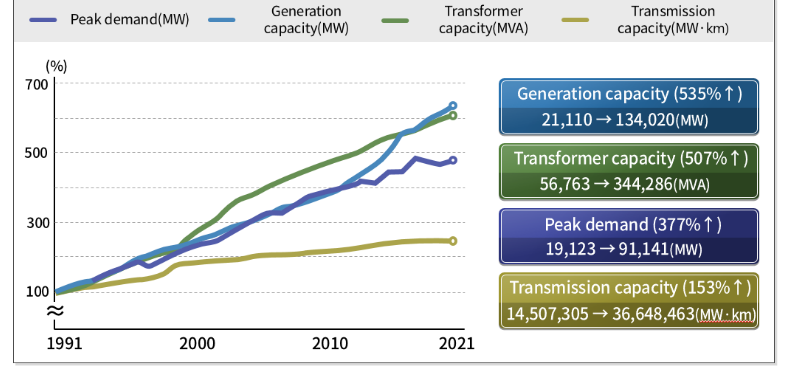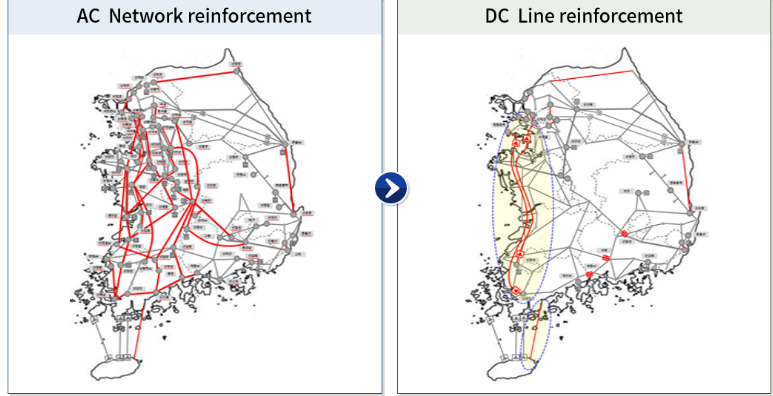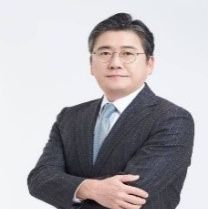The Future Grid of KEPCO
The Korean government forecasts that the country’s electricity consumption in 2036 would be 703TWh which is 1.7% average annual increase from that in 2021. With the growing demand, the country plans to expand renewable energy up to 30% which used to account for only 6.3% of the total national power generation in 2021.


President and CEO of Korea Electric Power Corporation (KEPCO)
Background
However, we need a shifted energy paradigm towards giving priority to grid expansion to make that happen, as transmission lines cannot be reinforced in a short period of time. Korea’s pivoting to such activity would give its grid the ability to integrate the renewable power before supplying it to end-users. At the same time, the country needs to have a more stable grid system to deal with increased variability and reduction of system inertia. To lead this energy transition, Korea Electric Power Corporation (KEPCO) is mandated to build a specific blueprint envisaging the future of Korea’s grid.

Peak demand and power facilities growth rate (1991 - 2021)
The Direction of Future Grid
For a better system integration, KEPCO has chosen to decentralize renewable power generated at a specific site as well as excess demand concentrated on particular areas. In parallel, we are going to expand the renewable capacity in the existing grid by, for example, using dynamic line rating (DLR).
Furthermore, renewable generation requires forecast and control to attend to variability that may undermine stability of the grid system. Securing resources that can provide flexibility or inertia for the system – such as energy storage systems (ESS), pumped storage hydropower and synchronous condensers – would also help make the grid more stable.
Design Concept of the Future Grid
Improvement of grid efficiency
It is becoming more challenging to reinforce the grids due to community complaints and tighter environmental regulations, while electrification is and going to continue happening in transport and industry. So KEPCO needs to focus on promoting more efficient use of the existing and newly installed facilities so as to avoid any unnecessary additional construction and on creating better public acceptance.
Minimize inter-regional power transmission through the balance of power supply and demand of respective regions
In Korea, highly populated mega cities demand electricity most, requiring supply from several large power stations. But the current infrastructure has some technical inconveniences: they are located along the coastline and connected to bulk power consuming areas through many transmission lines. However, almost all the local communities in between are reluctant to accept new power lines due to poor benefits from such installations. Consequently, balancing the supply and demand in each region becomes a crucial issue that must be solved preferentially.
Conventionally, individual power producers and customers with high power demand (e.g., industrial complexes and data centers) select their premises for operation without closely taking the grid situation into account. But for the past decades, grid inefficiencies and local complaints have been raised considerably. It necessitated us proactively creating decentralized ‘Renewable Energy Zones’ where different tiers of individual renewable producers can supply electricity. Consumption can also be controlled with allocation of power consumption quota to each region depending on their generation amount, which would help balance the supply and demand. Price signals, including ‘distance-based’ transmission tariff, should also be provided for the areas generating renewables or requiring huge amount of energy, to decentralize supply and demand and thereby achieve market equilibrium.
Increase transmission capacity of existing lines
Bloomberg New Energy Finance (BNEF) sees the tremendous importance of non-wires alternative (NWA) solutions as they may eliminate the need for additional transmission lines. KEPCO also has three technical solutions to make the most of the existing power grid.
The first is to raise either transmission voltage or transmission capacity by replacing or reinforcing the existing power system to provide more power soon. Secondly, we are introducing FACTS that controls power flow and reactive power that maintains system voltage and helps address transmission constraints, and the ESS to support those functions, to use the grid efficiently. Finally, the utility is developing DLR system that would enable flexible application of the carrying capacity depending on the real-time condition of the transmission. KEPCO will continue its efforts in developing and verifying various NWA technologies for the highest efficiency of the existing infrastructure.
Connect large-scale generators directly to areas with high demand
In Korea, the ratio of solar (PV) to wind installation capacity is 87 to 13 as of 2022, which is to be rebalanced to 60 to 40 by 2030. To that end, offshore wind has been chosen as an alternative at several potential sites that are clustered at the southwest of the peninsula far from the capital area.
KEPCO has come up with the construction plan of high-voltage direct-current (HVDC) transmission lines that would enable point-to-point power delivery from a large-scale offshore wind farm to the end-uses in the future, obviating the need to install AC lines and offering more efficient solutions.

Reinforcement of grid stability
Unlike the European grids that provide a cross-border power transmission interface, Korea’s power grid is completely isolated and lacks interconnection with that of neighboring countries, which gives a huge disadvantage. It is even more challenging for the country to ensure all-time power supply as its territory is so small that the same climate condition prevails over the country and therefore makes the renewable energy not dispatchable. Therefore, the issue of variability of renewable energy supplies cannot be addressed unless greater flexibility and resilience are secured.
Enhance flexibility against variation
Since renewable energy generation depends highly on weather conditions, we need a progressive scheme to monitor and control the weather-dependent variation both in the short term and the long term.
Korea sees its peak power demand would be 118 GW in 2036, and therefore ESS covering about 3.7GW has to be deployed to stably meet such high demand in real time taking the variable nature of renewables into consideration. For a long-term variation, the country requires 22.6GW of back-up capacity, such as long-duration energy storage and pumped storage hydropower. Sector coupling between electricity, hydrogen and heat would also be a game changer. In addition, given the costly and non-inertial nature of the ESS, we need to seek more flexibility mainly through developing technologies for flexible operation of thermal and nuclear power plants; utilizing EV batteries including waste batteries and V2G; using smart lightings with Internet of Things (IoT) functions; and maximizing utilization of demand side responses as resources through comprehensive management.
Many countries, including the United States, Germany, and Australia, acknowledge the importance of flexible resources in addressing variability of renewables, and have created a storage mix that mainly incorporate batteries and pumped storage hydropower and their own mid-to-long term national energy scheme accordingly. Their movement clearly indicates how significant it is to secure such flexible resources considering the big picture that government is illustrating.
Increase inertia for more stable frequency
Stable power system operation requires a high level of grid resilience to avoid any sharp fluctuation in frequency and voltage that may be caused by the failures of large-capacity generators or transmission lines. So, the more renewable energy portion takes up in the energy mix, the more do we need to secure strong resilience.
In the existing grid, many rotating generators are operating with considerably high inertia that absorbs the shocks primarily in the occurrence of facility failures. When these generators are replaced with inverters for renewable energy, such inertia would be decreased in proportion of such replacement.
KEPCO projects that the amount of inertia that must be secured in our grids until 2036 would be around 54GWs. To provide the necessary inertia, we need a proper set of synchronous condensers to provide 7GVar so that both frequency and voltage can be stabilized.
Establish a digital operation system with functions of monitoring, forecast and control of renewables
Increasing renewable energy would diminish the stability of the grid as it has both uncertainty and variability. It becomes much more complicated when more renewable power flows into the distribution lines; the power flow gets reverted and thereby becomes bi-directional.
We can improve visibility with a forecast and monitoring system, which will allow us to better deal with the variability of renewables. We also need a transformation into a distribution system operator (DSO) that performs active instruction and control of supply for decentralized energy flowing in a distribution line. A fair and transparent governance of such DSO requires legal and systemic foundations as well as infrastructure such as advanced distribution management system (ADMS) that effectively manage both renewable energy and distribution lines.
Concluding Remarks
Some people argue that the conventional power grid may become useless in a decentralized renewable-dominant power system. However, our experience shows that the importance of grid has never been highlighted more in terms of contribution to achieving the global ambition towards net zero. So, for KEPCO, boosting grid efficiency is one of our key missions to accomplish, which can help minimize additional installation of grids.
To shape the desired form of future grid, we also need decentralization of supply and demand of renewables so that local communities can be in market equilibrium, technology development for integration of renewables with low-capacity factors into the existing grids and minimize the reinforcement of AC lines using HVDC as the backbone of transmission lines. Other efforts would be to secure short-term and long-term flexible resources and inertia supplement facility to respond to variation and reduced inertia as well as to have technologies and infrastructure that enable stable grid operation using more elaborate energy management system.
These endeavors would drive us to be closer to our net zero target, and as the CEO of KEPCO, I will make sure that the power grid serves as the central pillar of the policy design that makes the entire national energy policy work. I hope the global power industry in its entirety also join the efforts to make enabling technologies for grid efficiency readily available.
About Mr. Cheong, Seung-Il

Mr. Cheong, Seung-Il is the President and CEO of Korea Electric Power Corporation (KEPCO), the government-owned power utility in the Republic of Korea responsible for the generation, transmission and distribution of electricity for the country. Before taking office, he served as the Vice Minister of Trade, Industry & Energy of Korea from 2018 to 2020. During his service, he engaged in the establishment of strategic plans of Korea covering a wide spectrum of areas, such as Energy Master Plan, Green New Deal and Energy Efficiency Innovation.
Banner & thumbnail credit: VDCM image on iStock

